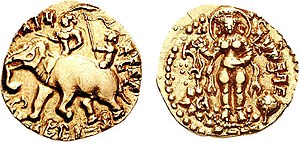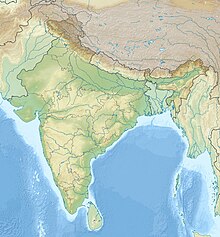Third Gupta Interregnum
An editor has asked for deletion of this article. |
| Third Gupta interregnum | ||||||||||
|---|---|---|---|---|---|---|---|---|---|---|
| Part of Wars of Gupta Empire | ||||||||||
| ||||||||||
| Belligerents | ||||||||||
| Skandagupta's Faction |
|
Ghatotkacha-gupta's Faction Prakashaditya's Faction | ||||||||
| Commanders and leaders | ||||||||||
| Skandagupta |
Ghatotkacha-gupta Prakashaditya | |||||||||
Historians believe that this conflict was caused by a fight over who would become king after Kumaragupta's death. Records suggest that several people claimed power during this time. These included Kumaragupta's brother Govindagupta, a relative named Ghatotkachagupta, and someone called Prakashaditya, known from his gold coins as well as his step brother Purugupta. They may have been rivals to Skandagupta for the throne.[1]
Skandagupta became king in the year 136 of the Gupta era (around 455-456 CE) by defeating others. According to the Bhitari pillar inscription, he saved his family's fortunes, which were in trouble. The inscription says that before fighting his enemies, he spent a night sleeping on the bare ground. He then defeated his enemies, who had become strong and wealthy. After his victory, he visited his mother, who was overjoyed and had tears in her eyes.[1]
25°34′00″N 83°17′20″E / 25.566654°N 83.288943°E
Background
[change | change source]Death of Kumaragupta I
[change | change source]Kumaragupta faced problems during his last years.[2] Some believe these troubles, mentioned in the Bhitari inscription, happened after his death due to a succession dispute.[1] Others think they were caused by a Huna invasion, as suggested by the Junagadh inscription, which says Skandagupta defeated the Hunas around 455 CE. It is also possible both events happened: Skandagupta fought the Hunas while a succession dispute occurred after Kumaragupta's death.[1]

Obv: Bust of King Kumaragupta with cap decorated with crescents.
Rev: Garuda bird, circled by legend in Brahmi "Parama-bhagavata rajadhiraja Sri Kumaragupta Mahendraditya" ("Most devout King of Kings Kumaragupta Mahendraditya").[4]


Skandagupta
[change | change source]Skandagupta was the son of Gupta emperor Kumaragupta I.[1] His mother's name is unknown, leading to different theories about her status.[6] Some believe she was a junior queen or of lower caste, based on a line in the Bhitari pillar inscription. However, others argue the inscription shows Skandagupta's respect for his mother, comparing her to Devaki, the mother of Krishna.
Some scholars suggest his mother’s name was Devaki, but historians like R. C. Majumdar believe the comparison highlights how Skandagupta restored her honor. Overall, evidence suggests she was a queen, making Skandagupta a legitimate heir.[1][7]


 Skan-da appears vertically under the left arm of the emperor.
Skan-da appears vertically under the left arm of the emperor.Rivals of Skandagupta
[change | change source]Ghatotkachagupta and Prakashaditya
[change | change source]Not much information about these two is available but Ghatotkachagupta, and Prakashaditya (who is known from some gold coins)[1] were probably the elder sons of Kumaragupta I also Ghatotkachagupta being the Governor of Eastern Malwa.[8]
Govindagupta
[change | change source]Chandragupta II was officially succeeded by his son Kumaragupta I, but a Basarh clay seal mentions Queen Dhruvasvamini as the mother of Govindagupta, not Kumaragupta.[1][9] Govindagupta may have been a governor of Tira-bhukti (Vaishali), which explains the seal's focus.
Some historians suggest Govindagupta briefly ruled after Chandragupta II’s death (c. 411-414 CE) before Kumaragupta took over.[10] Others believe he was a governor, regent, or rebel who created a short-lived kingdom in western Malwa.[8] Numismatist P. L. Gupta argued he ruled but was later overthrown by Kumaragupta.[2]
Most historians now agree Govindagupta was likely Kumaragupta’s younger brother and never ruled as king.
Purugupta
[change | change source]Purugupta was a son of the Gupta emperor Kumaragupta I and his queen Anantadevi. He became king after his half-brother Skandagupta. There are no inscriptions directly from Purugupta, but we know about him from other sources. His grandson Kumaragupta III mentioned him in the Bhitari silver-copper seal, and his sons Narasimhagupta and Budhagupta are known from Nalanda clay sealings.[9] His grandson Kumaragupta III also referred to him. The Sarnath Buddha image inscription suggests that Kumaragupta II became king after Purugupta.[9]

Prelude
[change | change source]Legitimacy of Skandagupta
[change | change source]The idea that Skandagupta's mother was not the Chief Queen and of low status was suggested by A.L. Basham, who misinterpreted a line in the Bhitari Pillar inscription as saying Skandagupta was "raised to Aryan status" by bards' praises. P.L. Gupta supported this, claiming the omission of his mother’s name indicated shame about her lower status.[7]
However, earlier scholars like Dr. Fleet translated the text differently, showing the bards simply praised Skandagupta's achievements. Recent studies confirm the text reflects Skandagupta’s humility, not his mother’s status. Court poets aimed to honor kings, making any negative suggestion about his lineage highly unlikely.[7]
गीतैश्च स्तुतिभिश्च वृत्तकथनैः यं हेपयत्यार्यता । Translation:Whom (his innate) nobility causes to blush by reason of the narrations of his exploits by means of songs and eulogies".
— Bhitari inscription of Skandagupta
The author of the inscription seems to have been inspired by the following verse of Kalidasa.[7]
तस्याभवत्सूनुरुदारशीलः शिलः शिलापट्टविशालवक्षाः । जितारिपक्षोऽपि शिलीमुखैर्यः शालीनतामब्रजदीड्यमानः॥ Translation: "His son was Śila, of high character, whose chest was broad like a slab of stone. Though he had conquered the ranks of his enemies by means of sharp arrows, he felt shy on account of his modesty, when he was eulogised ".
In summary, the suggestion that Skandagupta's mother was of low status is based on a misreading of the text.
Careful examination has shown that the real meaning of the inscription highlights Skandagupta's humility, not his mother's social status.
Third Gupta interregnum
[change | change source]Skandagupta's name is not mentioned in the genealogy of the Gupta rulers, which may be because the list in the Bhitari Seal only traces the line of the reigning king, rather than providing a full list of all the rulers.[1][2] It's also likely that Skanda-gupta's mother was not a Mahadevi, and for this reason, Skandagupta might not have automatically inherited the throne.[9] Instead, he had to fight for it against rivals like Purugupta and possibly others.[10]
This civil war nearly destroyed the Gupta Empire, which was on the verge of collapse, as stated in the Bhitari Pillar inscription. However, Skandagupta defeated his enemies and took the throne. The inscription compares him to Krishna, saying that just as Krishna went to his mother Devaki after defeating his enemies, Skandagupta did the same.[8][7][10] Some believe this comparison was made because his mother’s name was also Devaki, but it's more likely the comparison was meant to highlight the low status both Devaki and Skandagupta's mother had before their sons' victories brought them respect and power.[8][10]
The situation also helps explain the rise of other independent kings during this time. After the death of Kumaragupta I, a power struggle likely broke out, leading to the appearance of rulers like Govinda-gupta and Chatotkacha-gupta, who may have declared themselves independent. Another kings, Prakashaditya and Purugupta, also emerged around this time.[1] The civil war weakened the central power, allowing these chiefs to claim independence. However, Skandagupta defeated his rivals and restored his authority in less than a year after his father's death.[10]
Aftermath
[change | change source]During Skandagupta's reign, the Indo-Hephthalites (White Huns) invaded India from the northwest, reaching the Indus River.[1][13] Skandagupta defeated them in battle, causing heavy losses for the Hunas. The exact date of the invasion is unclear, but it likely occurred during Skandagupta's early reign or even during his father Kumaragupta’s time. Inscriptions from Junagadh and Bhitari mention Skandagupta’s victory over the invaders, probably the Hunas. A 7th-century Sanskrit text and a story from the Kathasaritsagara also refer to Skandagupta’s victory. He successfully repelled the Huna invasion, securing the empire.[8][13]
References
[change | change source]- ↑ 1.00 1.01 1.02 1.03 1.04 1.05 1.06 1.07 1.08 1.09 1.10 A Comprehensive History of India: pt. 1. A.D. 300-985. People's Publishing House. 1981. pp. 69–72.
- ↑ 2.0 2.1 2.2 Sharma, Tej Ram (1989). A Political History of the Imperial Guptas: From Gupta to Skandagupta. Concept Publishing Company. p. 176. ISBN 978-81-7022-251-4.
- ↑ Vincent Arthur Smith; Stephen Meredyth Edwardes (1924). The early history of India: from 600 B.C. to the Muhammadan conquest, including the invasion of Alexander the Great. Oxford : Clarendon Press. p. Coin plate No. 2.
- ↑ Virji, krishnakumari J. (1952). Ancient History Of Saurashtra. p. 225.
- ↑ CNG Coins [1]
- ↑ Kulke, Hermann; Rothermund, Dietmar (2004). A History of India. Psychology Press. p. 96. ISBN 978-0-415-32919-4.
- ↑ 7.0 7.1 7.2 7.3 7.4 "Vol. 48/49, 1968 of Annals of the Bhandarkar Oriental Research Institute on JSTOR". www.jstor.org. p. 325-327. Retrieved 2024-12-17.
- ↑ 8.0 8.1 8.2 8.3 8.4 History Of The Imperial Guptas. pp. 266–273.
- ↑ 9.0 9.1 9.2 9.3 Agrawal, Ashvini (1989). Rise and Fall of the Imperial Guptas. Motilal Banarsidass Publ. p. 186. ISBN 978-81-208-0592-7.
- ↑ 10.0 10.1 10.2 10.3 10.4 K. K Dasgupta (1960). A Comprehensive History Of India Vol. 3, Part. 1. pp. 66–72.
- ↑ Corpus Inscriptionum Indicarum Vol.3 (inscriptions Of The Early Gupta Kings) p.364
- ↑ "Junagadh Rock Inscription of Rudradaman", Project South Asia. Archived 23 February 2009 at the Wayback Machine
- ↑ 13.0 13.1 Jaques, Tony (2007). Dictionary of Battles and Sieges: A Guide to 8500 Battles from Antiquity Through the Twenty-first Century. Miegunyiah Press. p. 471. ISBN 978-0-522-85336-0.





